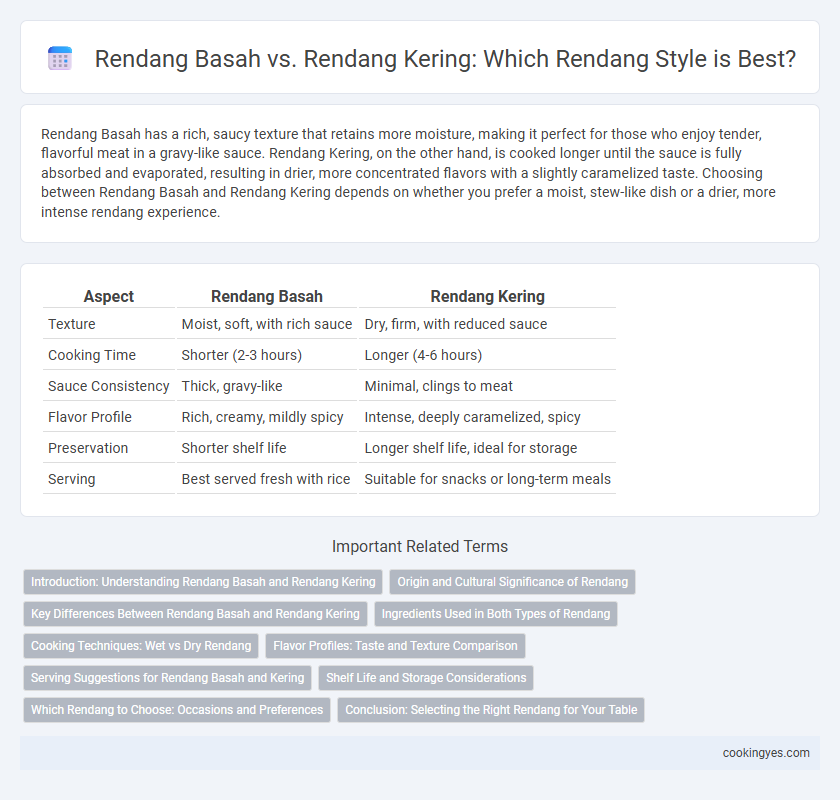Rendang Basah has a rich, saucy texture that retains more moisture, making it perfect for those who enjoy tender, flavorful meat in a gravy-like sauce. Rendang Kering, on the other hand, is cooked longer until the sauce is fully absorbed and evaporated, resulting in drier, more concentrated flavors with a slightly caramelized taste. Choosing between Rendang Basah and Rendang Kering depends on whether you prefer a moist, stew-like dish or a drier, more intense rendang experience.
Table of Comparison
| Aspect | Rendang Basah | Rendang Kering |
|---|---|---|
| Texture | Moist, soft, with rich sauce | Dry, firm, with reduced sauce |
| Cooking Time | Shorter (2-3 hours) | Longer (4-6 hours) |
| Sauce Consistency | Thick, gravy-like | Minimal, clings to meat |
| Flavor Profile | Rich, creamy, mildly spicy | Intense, deeply caramelized, spicy |
| Preservation | Shorter shelf life | Longer shelf life, ideal for storage |
| Serving | Best served fresh with rice | Suitable for snacks or long-term meals |
Introduction: Understanding Rendang Basah and Rendang Kering
Rendang Basah features a moist, saucy texture with a rich coconut milk base, preserving its tender meat in a flavorful, slow-cooked gravy. Rendang Kering, known as dry rendang, undergoes longer cooking times until the liquid evaporates, resulting in a drier, caramelized coating that intensifies its spice and aroma. Both variations showcase traditional Minangkabau culinary artistry, highlighting diverse textures and flavor profiles within Rendang cuisine.
Origin and Cultural Significance of Rendang
Rendang originates from the Minangkabau ethnic group of West Sumatra, Indonesia, with "Rendang Basah" and "Rendang Kering" representing two traditional cooking styles reflecting regional preferences. Rendang Basah is a moist, stew-like version cooked for a shorter time, common in coastal areas, preserving more liquid and tenderness, while Rendang Kering is a dry, deeply caramelized variant, cooked longer until all liquid evaporates, symbolizing endurance and patience. Both variations hold deep cultural significance as ceremonial dishes served during Minangkabau weddings and festive celebrations, embodying community values and ancestral heritage.
Key Differences Between Rendang Basah and Rendang Kering
Rendang Basah features a moist texture with a rich, coconut milk-based sauce that retains more liquid, making it ideal for immediate consumption. Rendang Kering, on the other hand, is cooked longer until the sauce reduces and the meat becomes dry and caramelized, enhancing its shelf life and intensifying flavor. The key difference lies in the moisture content and cooking duration, affecting texture, taste, and preservation methods.
Ingredients Used in Both Types of Rendang
Rendang Basah typically uses fresh coconut milk, a variety of herbs like lemongrass and galangal, and a balanced mix of spices including turmeric and ginger to create a moist, rich texture. Rendang Kering involves cooking the same base ingredients longer, allowing the coconut milk to fully evaporate and the spices to intensify, resulting in a drier, thicker consistency. Both types rely heavily on beef as the protein, but the key difference lies in the moisture content controlled by the cooking duration and coconut milk reduction.
Cooking Techniques: Wet vs Dry Rendang
Rendang Basah involves cooking the meat in a rich coconut milk sauce until tender but still moist, preserving a soft texture and vibrant flavors. Rendang Kering, on the other hand, is simmered longer until the liquid evaporates, resulting in a drier, caramelized exterior with intensified spices. The wet method emphasizes creamy consistency, while the dry method enhances shelf life and deep, concentrated taste.
Flavor Profiles: Taste and Texture Comparison
Rendang Basah features a rich, tender texture with a moist, saucy consistency that intensifies its complex, savory flavors infused with coconut milk and aromatic spices. Rendang Kering offers a drier, caramelized exterior with a firmer, chewier bite, highlighting deeper, concentrated spices and a subtle sweetness from the prolonged cooking process. The contrast in moisture levels directly affects the mouthfeel and flavor release, making Rendang Basah more succulent while Rendang Kering delivers a robust, intensified taste experience.
Serving Suggestions for Rendang Basah and Kering
Rendang Basah, characterized by its moist and tender texture, pairs exceptionally well with steamed white rice or ketupat, enhancing the rich coconut and spice flavors. Rendang Kering, known for its drier, more concentrated taste, is ideal as a savory side dish or topping for lontong and nasi lemak, providing a robust, caramelized aroma. Both variations complement fresh vegetable sides such as acar timun or sambal, balancing the rich, spicy profiles.
Shelf Life and Storage Considerations
Rendang Basah has a shorter shelf life of approximately 2-3 days when refrigerated due to its higher moisture content, making it prone to spoilage if not consumed quickly. Rendang Kering, with its reduced moisture and thicker gravy, can last up to 1-2 weeks in the refrigerator, offering better storage stability. Proper storage in airtight containers and refrigeration at temperatures below 4degC are essential to maintain the quality and safety of both types.
Which Rendang to Choose: Occasions and Preferences
Rendang Basah features a moist, saucy texture ideal for everyday meals and family gatherings, offering rich, tender beef simmered in coconut milk and spices. Rendang Kering is drier and has a longer shelf life, making it perfect for festive occasions and celebrations where longevity and intensified flavors are preferred. Choosing between Rendang Basah and Rendang Kering depends on the occasion's formality and personal preference for texture and flavor concentration.
Conclusion: Selecting the Right Rendang for Your Table
Choosing between Rendang Basah and Rendang Kering depends on your preference for texture and flavor intensity; Rendang Basah offers a moist, rich experience with a saucier consistency, ideal for those seeking tender beef infused with coconut milk and spices. Rendang Kering, on the other hand, is a dry, caramelized version that delivers a concentrated, deep flavor and longer shelf life, perfect for serving as a savory condiment or for extended meals. Selecting the right rendang involves considering how you want to balance richness, seasoning depth, and serving style to complement your culinary setting.
Rendang Basah vs Rendang Kering for Rendang Infographic

 cookingyes.com
cookingyes.com